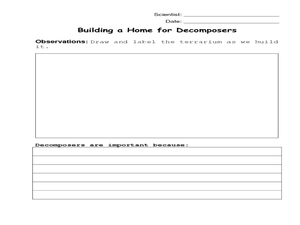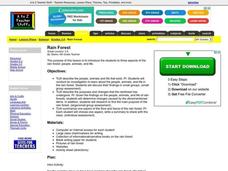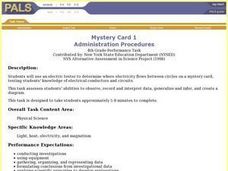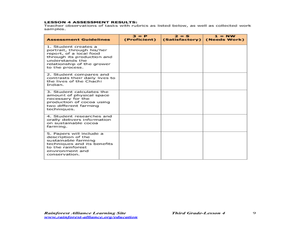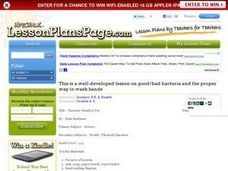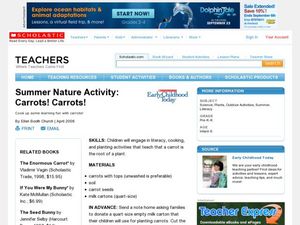Curated OER
What Bees Eat
Students study plant and animal interdependence by studying bees and pollination. In this interdependence lesson, students discuss flower parts and dissect it to show its reproductive parts. Students then use tissue and pipe cleaners to...
Curated OER
What Do Snails Eat?
Students conduct a food choice experiment with snails, recording the results on a chart to determine what snails eat. In this what do snails eat lesson plan, students color a picture of snail anatomy, perform the experiment with 3...
Curated OER
De-composers - Terrarium
Students explore the environment by building a mock ecosystem. In this rainforest analysis activity, students define many environmental and rainforest related vocabulary terms and discuss the current status of our planet's rainforests....
Curated OER
Incredible Seeds
Second graders are given a group of seeds and put in small groups. They classify their seeds based on their observations with 90% accuracy. Students draw a picture of each seed showing at least 2 characteristics of each. They write 1...
Curated OER
Send Me A Postcard From The Rainforest
Students research the different regions of the rainforest by using the Internet. They create their own postcards from each region they examine showing the plants and animals of that region. They share their postcards with the class.
Curated OER
Balls and Ramp
Students role several balls of different weights down a ramp and into a paper cup and record how far each ball made the paper cup move. They then answer questions that help them analyze their results and reinforce the idea that energy...
Curated OER
Rain Forest
Young scholars discover three aspects of the rain forest. They describe the people, animals, and vegetation in the rain forest. They identify the changes the rain forest has gone through and the reasons behind the changes. They choose...
Curated OER
Buggy Diner
Students observe different insects and the different kinds of foods they like to eat. In this insects lesson plan, the teacher collects insects and different plants and roots. Then the students learn about those insects and have to be...
Curated OER
Living and Non-Living
Young scholars discover the basic needs of life. In this science lesson plan, students explore how all living things need air, water, food and shelter
Curated OER
How Does a Green Plant Grow?
Students examine how a seed grows, and design an experiment to explore this concept. They make predictions, conduct the experiment, record the results, and interpret the results.
Curated OER
WHERE'S THE BEEF?
The student will become visually aware of the different shapes of wholesale cuts of beef.1. Ask a local meat cutter to make a class visit to explain his or her job. 2. Enlarge the steer outline on Student Worksheet B, and place it on a...
Curated OER
My Little Seed House
First graders chart the growth and development of seeds. In this seed growth lesson, 1st graders observe seeds as they mature through the growing process.
Curated OER
Mystery Card 1
Students test their knowledge of electrical conductors and circuits by constructing an electric tester and using it to determine where electricity flows between circles on a mystery card.
Curated OER
Equadorian Rainforest: The Tropical Supermarket
Students study the concept of sustainable agricultural practices through cocoa farming and the lives of the people who are the producers. Students watch a slide show and read a story which helps them understand the origins of chocolate,...
Curated OER
Bacteria: Friend or Foe?
Students examine a variety of environmental and industrial roles of bacteria. explore where bacteria can be found and distinguish bacteria from other organisms.
Curated OER
I See a Coyote
Students role-play coyotes looking for natural resources. In this natural resources lesson, students examine the relationship between animal life and the environment. Students play a game that demonstrates how natural...
Curated OER
Seed Sorting 101
Students sort through numerous seeds to find similarities and differences. In this sorting and classifying lesson, students divide up different plant seeds based on their similarities and differences, while keeping record of their findings.
Curated OER
How are Seeds Alike and Different?
Second graders examine the seeds in fresh fruit. In this seeds instructional activity, 2nd graders view different seeds and tell how they are alike and different. Students separate the seeds into groups according to their...
Curated OER
Summer Nature Activity: Carrots! Carrots!
Young scholars investigate reading, cooking, and planting activities that teach that a carrot is the root of a plant. In this early childhood science lesson, students explore the world around them as they read The Carrot Seed and...
Curated OER
Beanie Baby
Students will explain the importance of soybeans. In this science lesson, students participate in making a "beanie baby" necklace. Additionally, students observe their soybeans for germination and growth for 7-10 days. Students record...
Curated OER
The Transformation and Use of Different Types of Energy Using Local Flora and Fauna in a Vietnam Village Setting
Eighth graders examine the concept that the sun is the ultimate source of energy for living things. They conduct an experiment in which they roast marshmallows over a flame that has been produced from methane gas, which originates from...
Curated OER
The Water Cycle: Transpiration
Young scholars identify and describe the stages in the water cycle. Using plants, they determine if they play a role in the cycle and measure the water the plants give off. They complete an experiment to determine if deciduous or...
Curated OER
Inside the Egg, Hatching Chickens
Learners conduct an egg candling activity to show the life inside a fertile egg. Students discuss the needs the egg has of the hen, as well as similarities and differences between plants and animals. Learners complete a life cycle wheel...


